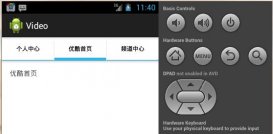本文实例讲述了android编程实现网络图片查看器和网页源码查看器。分享给大家供大家参考,具体如下:
网络图片查看器
清单文加入网络访问权限:
|
1
2
|
<!-- 访问internet权限 --><uses-permission android:name="android.permission.internet"/> |
界面如下:

示例:
|
1
2
3
4
5
6
7
8
9
10
11
12
13
14
15
16
17
18
19
20
21
22
23
24
25
26
27
28
29
|
public class mainactivity extends activity { private edittext imagepath; private imageview imageview; @override public void oncreate(bundle savedinstancestate) { super.oncreate(savedinstancestate); setcontentview(r.layout.main); imagepath = (edittext) this.findviewbyid(r.id.imagepath); imageview = (imageview) this.findviewbyid(r.id.imageview); button button = (button) this.findviewbyid(r.id.button); button.setonclicklistener(new view.onclicklistener() { public void onclick(view v) { string path = imagepath.gettext().tostring(); try{ byte[] data = imageservice.getimage(path);//获取图片数据 if(data!=null){ //构建位图对象 bitmap bitmap = bitmapfactory.decodebytearray(data, 0, data.length); imageview.setimagebitmap(bitmap);//显示图片 }else{ toast.maketext(getapplicationcontext(), r.string.error, 1).show(); } }catch (exception e) { toast.maketext(getapplicationcontext(), r.string.error, 1).show(); } } }); }} |
|
1
2
3
4
5
6
7
8
9
10
11
12
13
14
15
16
17
18
19
20
|
public class imageservice { /** * 获取图片 * @param path 网络图片路径 * @return 图片的字节数据 */ public static byte[] getimage(string path) throws exception{ url url = new url(path); httpurlconnection conn = (httpurlconnection) url.openconnection(); //设置超时时间 conn.setconnecttimeout(5000); conn.setrequestmethod("get"); if(conn.getresponsecode()==200){ inputstream instream = conn.getinputstream(); byte[] data = streamtool.read(instream); return data; } return null; }} |
|
1
2
3
4
5
6
7
8
9
10
11
12
13
14
15
16
17
|
public class streamtool { /** * 读取输入流数据 * @param instream * @return */ public static byte[] read(inputstream instream) throws exception{ bytearrayoutputstream outstream = new bytearrayoutputstream(); byte[] buffer = new byte[1024]; int len = 0; while( (len = instream.read(buffer)) != -1 ){ outstream.write(buffer, 0, len); } instream.close(); return outstream.tobytearray(); }} |
网页源码查看器
如果网页的源码超过屏幕的显示位置的话,要求出现滚动条.
|
1
2
3
4
5
6
7
8
9
10
|
<scrollview android:layout_width="wrap_content" android:layout_height="wrap_content"><textview android:layout_width="fill_parent" android:layout_height="wrap_content" android:id="@+id/htmlsource" /></scrollview> |
界面如下:

示例
|
1
2
3
4
5
6
7
8
9
10
11
12
13
14
15
16
17
18
19
20
|
@overridepublic void oncreate(bundle savedinstancestate) { super.oncreate(savedinstancestate); setcontentview(r.layout.main); pathtext = (edittext) this.findviewbyid(r.id.path); htmlsource = (textview) this.findviewbyid(r.id.htmlsource); button button = (button) this.findviewbyid(r.id.button); button.setonclicklistener(new view.onclicklistener() { public void onclick(view v) { string path = pathtext.gettext().tostring(); try{ //获取源码 string html = pageservice.gethtml(path); htmlsource.settext(html); }catch (exception e) { toast.maketext(getapplicationcontext(), r.string.error, 1).show(); } }});} |
|
1
2
3
4
5
6
7
8
9
10
11
12
13
14
15
16
17
18
|
public class pageservice { /** * 获取网页源代码 * @param path 网页路径 * @return */ public static string gethtml(string path) throws exception{ url url = new url(path); httpurlconnection conn = (httpurlconnection) url.openconnection(); conn.setconnecttimeout(5000); conn.setrequestmethod("get"); if(conn.getresponsecode() == 200){ byte[] data = streamtool.read(conn.getinputstream()); return new string(data, "utf-8"); } return null; }} |
希望本文所述对大家android程序设计有所帮助。














